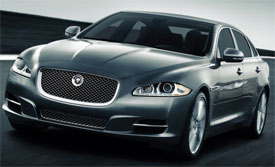2011 Jaguar XJ
Even before their divorce from Ford, Jaguar was transforming its cars from a classic grand touring image of the 20th century to a British showcase of sophisticated motoring for the 21st century. Now, the mid-size XF sedan set the stage, but everyone knew the make-or-break star would be the top-tier XJ saloon. Now, our first impressions were very positive. So let’s have a complete critique.
The all-new 2011 Jaguar XJ follows the XF into a bold new world of styling for this classic brand. Aside from grille texture and badging, Design Director Ian Callum has left nary a hint of the previous XJ, choosing to go back further for inspiration. Instead of the familiar four-orb headlights, two swept-back cats-eye lamps are set in low, sculpted fenders. But XJ heritage is still sensed in the rounded-off grille and long hood that date back to the original 1968 Series I.
With so much sloping glass, there is very little trunklid. Blacked-out C-pillars are definitely an eclectic touch. LED taillights pour down the XJ’s elegantly simple, tapered tail, adorned only with a chrome Leaper.
 The mid-size XF’s potent trio of 5.0-liter direct-injected V8s provides plenty of go for the larger XJ as well. Base unit is naturally aspirated with 385 horsepower and 380 pound-feet of torque. The Supercharged XJ’s belt-driven breathing is good for a stout 470 horses and 424 pound-feet.
The mid-size XF’s potent trio of 5.0-liter direct-injected V8s provides plenty of go for the larger XJ as well. Base unit is naturally aspirated with 385 horsepower and 380 pound-feet of torque. The Supercharged XJ’s belt-driven breathing is good for a stout 470 horses and 424 pound-feet.
The special-order Supersport adds the 510-horsepower eight from the XFR. The only transmission, a six-speed automatic, presses the hockey puck-JaguarDrive Selector into your palm at startup. There are also wheel-mounted paddle shifters, and driver selectable Dynamic mode that holds gears longer while also firming up the suspension and seat belts!
With a mean growl, our 385-horse XJ leaped from 0 to 60 in 5.8 seconds, and raced through the quarter mile in 14.3 seconds at 103 miles per hour. It does bog down momentarily at launch. Without that, times would be even faster. Still, results closely match the XF, thanks to the aluminum chassis that allows the XJ to enter the ring some 300 lbs lighter than its rivals.
That chassis is supported by standard air suspension with continuously variable damping. Driving aids include the expected stability and traction control, plus an active rear differential. The combo makes for a supple ride and sublime handling-once you get used to the quick but dead steering, that is. The lack of feedback reminded us of a video game. But, get the hang of it, and this big Jag easily mastered every corner we threw at it. Yes, it rolls a bit, but overall it is well balanced and unflappable.
But you always know what the brakes are doing. An initial soft pedal is followed by good bite. A 131 foot average coming down from 60 could be shorter, but stability is excellent and the experience is far smoother than most rivals.
 And, no rival can match the way Jaguar dresses its interiors. Wood veneer rings a spacious, amazingly well equipped cabin, whose low-slung leather dash is shrink-wrapped around nautical-style vents.
And, no rival can match the way Jaguar dresses its interiors. Wood veneer rings a spacious, amazingly well equipped cabin, whose low-slung leather dash is shrink-wrapped around nautical-style vents.
Classic round gauges reside in a virtual world, as a driver-focused 12.3-inch display fades up at startup, highlights critical data, and tints red in ‘Dynamic’ mode.
A center eight-inch Dual View touch screen allows the driver and front passenger to view two different visuals at the same time. It fits right below a classic analog timepiece.
Very modern is the standard panoramic glass roof. There’s ample storage, including Jaguar’s one-touch opening glovebox, and very usable cupholders in the center console. In the rear, leather covers the seats, door panels, and even the headliner is suede cloth. While there is plenty of room, long wheelbase models expand it to limousine proportions. The Jaguar’s 18.4 cubic feet of trunk volume is decent, though less than Mercedes’ S-Class.
Government Fuel Economy for our XJ are 16 city/23 highway on premium fuel. We hit a respectable 20.0 miles per gallon in real world driving. The new XJ has a base price of $72,500, which makes Jag’s flagship a segment bargain. The supercharger adds $15,000 more, with the SuperSport in six figures. On all, the long wheelbase tacks on a few grand additional.
The 2011 Jaguar XJ bridges the gap between two eras beautifully. Never once do classic inspirations and eclectic touches mar the totally modern outcome in the slightest. With extroverted style and performance aplenty, Jaguar’s big cat roars into the 21st century with its claws out.
Specifications
- Engine: 5.0-Liter Direct-injected V8
- Horsepower: 385
- Torque: 380 Lb Feet
- 0-60 MPH: 5.8 Seconds
- 1/4 Mile: 14.3 Seconds @ 103 MPH
- 60-0 MPH: 131 Feet
- EPA: 16 MPG City/ 23 MPG Highway
- Mixed Loop: 20.0 MPG
2025 Volkswagen ID. Buzz
Volkswagen Brings Beetlemania Level Of Excitement To Minivan Segment
The duty of upholding Volkswagen’s heritage has most recently been delegated to small legacy car names like Golf and Jetta. But hold on! A much larger, totally modern take on VW’s classic microbus has just buzzed over the horizon— the all-electric ID. Buzz. It’s been at the top of our minds since we first saw the concept back in 2017. Well, it’s finally here, so let’s get our groove into drive!
This 2025 Volkswagen ID. Buzz has indeed created the most buzz around Volkswagen since the Beetle’s return to the U.S. in the late 1990s. We couldn’t drive it anywhere without drawing a crowd. No wonder, just about everyone has a VW Microbus story to tell, and seeing this reimagined version rolling down the street brings back all those memories.
VW really pulled it off as far as we’re concerned, as it looks great without appearing over the top. All the cues are here: Big VW logo front and center, lots of greenhouse including A-pillar windows and mini sliders for the second-row passengers, D-pillar air vents, and two-tone wheels. And while its appearance may be pure retro, its drivetrain is far from it, as the ID. Buzz is all-electric, and unlike the new Beetle, the Buzz does retain the original Microbus’ rear-drive architecture.
Powering those rear wheels is a 210-kW motor drawing juice from a 91-kWh battery for a range of 234 miles; 200-kW max charging will get you to 80% in about 26 minutes. Buyers can add another small 80-kW motor up front for 4motion all-wheel-drive and an increase of total output from 282 to 335 horsepower with a combined 512 lb-ft of torque. It uses the same battery, but range estimates drop just slightly to 231 miles. But while those numbers are modest, we also found them to be quite conservative, as we observed as many as 287 miles available in our all-wheel-drive tester’s gauge display and were on pace for 273 miles in our driving loop.
One throwback theme that may be a turnoff to some is that it’s quite a step up into the Buzz’s front seats, but there’s certainly a commanding view of the road once you climb in. Second row seating can be either a three-place bench or a pair of captain’s chairs, so there’s generous room for seven or six passengers. The captain’s chairs in our Pro S Plus offer good support and very easy access to the third row.
Lots of flexibility too with the option to simply fold the seats or remove them altogether.
With the sliding side doors and a wide opening rear hatch, there’s plenty of access for loading big sport utility amounts of cargo. Lots of flexibility too with the option to simply fold the seats or remove them altogether, and the ability to create a full-length flat floor with a rear cargo shelf that covers some handy removable storage bins. There’s 18.6 cubic-feet of space behind the third row, 75.5 behind the second, and a max of 145.5. That’s more than a Chevrolet Tahoe. For smaller items, there are lots of cubbies throughout the cabin, along with a standard Buzz Box that can be moved to multiple locations.
With a design that prioritizes retro form and modern function over aero efficiency, the 4motion equipped ID. Buzz earns a Fair efficiency rating, using 42-kWh of electricity per 100 miles, and we weren’t sure what to expect at our Mason Dixon test track.
What we found was great torque off the line and drama free launches to 60 in just 5.3 seconds. It was very stable at speed and power delivery stayed steady most of the way down the track until we reached about 90 mph, when it began to taper off just before we finished the quarter-mile in 14.0 seconds flat at 97 mph.
With 1,200-lbs. of battery weight nestled in its 127.5-inch wheelbase, the Buzz felt planted to the pavement through our handling course. There was quite a bit of body roll to deal with, but surprisingly little understeer. In panic braking runs, pedal response was inconsistent, feeling soft at times, pushing back hard at others; but through it all, results were quite good, stopping from 60 in an average of just 108 feet.
Three interior themes are available, this Dune is the brightest, featuring coastal inspired wood optic dash décor, “gray and clay” leatherette surfaces, and a high-mounted central 12.9-inch touchscreen. Pricing starts with a rear-wheel-drive Pro S at $61,545; this Pro S Plus begins at $65,045, add another $4,500 for 4motion, which brings a few extra features along with all-wheel drive.
Retro design with old-school VW charm, modern EV drivetrain, big SUV capacity merged with minivan flexibility; it all comes together in this 2025 Volkswagen ID. Buzz. It’s easily one of the coolest rides of the year and one that will likely keep Volkswagen dealers buzzing for years to come, and that’s something no other people and things mover can say.
Specifications
As Tested
- Motor Setup: Dual-Motor AWD
- Battery Size: 91-kWh
- Horsepower: 335
- Torque: 512 lb-ft
- EPA Range: 231 miles
- 0-60 mph: 5.3 seconds
- 1/4 Mile: 14.0 seconds at 97 mph
- Braking, 60-0: 108 feet
- MW Test Loop: ~ 273 miles













































